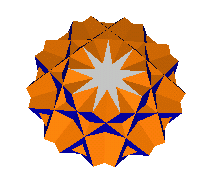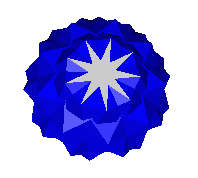

Spheno-coronas
 |
 |
Type (A): n/d-4-3-3-4, Type (B): 4-3-3-3, Type (C): 3-3-3-3-3, Type (D): n/d-3-3-3-3-3
The pattern of the vertices is best seen on this vertex coloured model of a 5/2 spheno-corona which has the vertices coloured (A) red, (B) yellow, (C) green, (D) blue.
The only n-gonal convex member of this family is the Johnson Solid sphenocorona or the "Digonal Spheno-Corona" with n=2. If n=3 then the resulting Triangular Spheno-Corona is clearly non-convex.
The family is locally convex in the range 2 <= n/d < ~2 3/8. The upper limit has not been precisely determined. However investigation of solids around this limit shows 2.3333 (7/3) to be convex whilst at 2.4 (12/5) the Type (A) vertices are non-convex. 2.375 (19/8) appears to be very close to the limit, no deviation from coplanarity is evident on this model with only one rotation around the symmetry axis. It must be stressed that the upper convexity limit has to date only been assessed from a visual examination of the VRML models and has not been explicitly determined.
Spheno-coronas also exist for n/d<2, in these cases local convexity is lost as the base n/d-gons become retrograde. In the specific case of the 5/3 spheno-corona the type (C) vertices appear to be in co-located in a ring of pairs around the solid. This is not the case however for the 7/4 spheno-corona or the 9/5 spheno-corona.
Spheno-coronas with d>1 and
n<=12
for 2<n/d<=2.5 are listed below. Those in yellow cells and
followed by a * are non-convex:
| 5/2* | 7/3 | 9/4 | 11/5 | 12/5* |
Isomorphs
There appear to be two distinct
isomorphs to the spheno-corona. The first, which I term the 'everted'
isomorph has the type (C) vertices starred and also has the type (A) and
(D) vertices at opposite ends of the solid. The second, which I term
the 'inverted' isomorph has the type (C) vertices crossed (rather
than starred) and has the type (A) and (D) vertices to one side of the
solid with the type (B) and (C) vertices forming a coplanar, faceted face.
For each form (base, everted isomorph, inverted isomorph) there are two forms,
a base form and a form where the base polygon is retrograde. This
gives six isomorphs in total which are displayed below. In the
case of the 5/2 spheno-corona and its isomorphs, the word 'vertex' below links to models coloured by vertex. The 5/2 spheno-corona also has
a large number of non-symmetrical isomers (example),
a feature which does not appear to be the case for the 7/3 or 9/4 spheno-coronas.